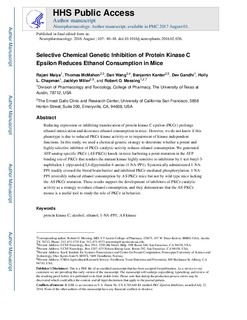| dc.contributor.author | Maiya, Rajani | |
| dc.contributor.author | McMahon, Thomas | |
| dc.contributor.author | Wang, Dan | |
| dc.contributor.author | Kanter, Benjamin Richard | |
| dc.contributor.author | Gandhi, Dev | |
| dc.contributor.author | Chapman, Holly L | |
| dc.contributor.author | Miller, Jacklyn | |
| dc.contributor.author | Messing, Robert O | |
| dc.date.accessioned | 2017-12-08T09:31:24Z | |
| dc.date.available | 2017-12-08T09:31:24Z | |
| dc.date.created | 2016-12-13T12:48:49Z | |
| dc.date.issued | 2016 | |
| dc.identifier.citation | Neuropharmacology. 2016, 107 40-48. | nb_NO |
| dc.identifier.issn | 0028-3908 | |
| dc.identifier.uri | http://hdl.handle.net/11250/2469694 | |
| dc.description.abstract | Reducing expression or inhibiting translocation of protein kinase C epsilon (PKCε) prolongs ethanol intoxication and decreases ethanol consumption in mice. However, we do not know if this phenotype is due to reduced PKCε kinase activity or to impairment of kinase-independent functions. In this study, we used a chemical-genetic strategy to determine whether a potent and highly selective inhibitor of PKCε catalytic activity reduces ethanol consumption. We generated ATP analog-specific PKCε (AS-PKCε) knock-in mice harboring a point mutation in the ATP binding site of PKCε that renders the mutant kinase highly sensitive to inhibition by 1-tert-butyl-3-naphthalen-1-ylpyrazolo[3,4-d]pyrimidin-4-amine (1-NA-PP1). Systemically administered 1-NA-PP1 readily crossed the blood brain barrier and inhibited PKCε-mediated phosphorylation. 1-NA-PP1 reversibly reduced ethanol consumption by AS-PKCε mice but not by wild type mice lacking the AS-PKCε mutation. These results support the development of inhibitors of PKCε catalytic activity as a strategy to reduce ethanol consumption, and they demonstrate that the AS- PKCε mouse is a useful tool to study the role of PKCε in behavior. | nb_NO |
| dc.language.iso | eng | nb_NO |
| dc.publisher | Elsevier | nb_NO |
| dc.rights | Attribution-NonCommercial-NoDerivatives 4.0 Internasjonal | * |
| dc.rights.uri | http://creativecommons.org/licenses/by-nc-nd/4.0/deed.no | * |
| dc.title | Selective chemical genetic inhibition of protein kinase C epsilon reduces ethanol consumption in mice | nb_NO |
| dc.type | Journal article | nb_NO |
| dc.type | Peer reviewed | nb_NO |
| dc.description.version | acceptedVersion | nb_NO |
| dc.source.pagenumber | 40-48 | nb_NO |
| dc.source.volume | 107 | nb_NO |
| dc.source.journal | Neuropharmacology | nb_NO |
| dc.identifier.doi | 10.1016/j.neuropharm.2016.02.036 | |
| dc.identifier.cristin | 1412091 | |
| dc.relation.project | Norges forskningsråd: 10399107 | nb_NO |
| dc.relation.project | Internasjonale institusjoner: NIH grants AA13588 & AA017072 | nb_NO |
| dc.relation.project | Kavli Foundation: 47062005 | nb_NO |
| dc.description.localcode | © 2016. This is the authors’ accepted and refereed manuscript to the article. This manuscript version is made available under the CC-BY-NC-ND 4.0 license http://creativecommons.org/licenses/by-nc-nd/4.0/ | nb_NO |
| cristin.unitcode | 194,65,60,0 | |
| cristin.unitname | Kavliinstitutt for nevrovitenskap | |
| cristin.ispublished | true | |
| cristin.fulltext | postprint | |
| cristin.qualitycode | 1 | |

